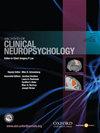A - 22 Baseline testing for athletes: where are we now and where are we going?
IF 2.1
4区 心理学
Q2 PSYCHOLOGY
引用次数: 0
Abstract
The purpose of this pilot study is to find out the current state of baseline neurocognitive testing for athletes across multiple ages and organizations, by gathering information from professionals in the field. 16 sports neuropsychologists completed a one-time anonymous online survey that contained questions regarding concussion baseline testing practices and opinions. 15 sports neuropsychologists answered “yes”to conducting baseline testing, with one responding “no.”Of those, 10 reported working with professional athletes, 8 with college athletes, 8 with adolescents aged 13–17, and 5 with children aged 8–12. All 15 sports neuropsychologists reported using the Immediate Post-concussion Assessment and Cognitive Testing (ImPACT), in accordance with other measures such as the VOMS, sway, force platform, SCAT, and traditional paper and pencil measures, among other assessments. Baseline testing took place in the sports medicine clinic, at the sports facility, at the university, private office, or research lab. A majority of the sports neuropsychologists reported that testing was supervised by themselves, an athletic trainer, student trainee, and/or clinic staff. A portion (20%) of the sports neuropsychologists indicated they were not satisfied with their current method of baseline testing. One neuropsychologist reported that they currently conduct remote baseline testing and a minority of the respondents stated they would consider remote testing. There was a consensus on the use of the ImPACT as the main baseline neurocognitive measure, among other assessments. This study should be expanded to include a larger sample size and variety of sports professionals to better understand the current state of sport concussion assessment.A - 22 运动员基线测试:现状与未来?
这项试点研究的目的是通过收集该领域专业人士的信息,了解不同年龄段和不同组织的运动员神经认知基线测试的现状。 16 名运动神经心理学家完成了一次性匿名在线调查,其中包含有关脑震荡基线测试实践和意见的问题。 15 名运动神经心理学家回答 "是 "进行基线测试,1 名回答 "否"。其中,10 名运动神经心理学家的工作对象是职业运动员,8 名是大学生运动员,8 名是 13-17 岁的青少年,5 名是 8-12 岁的儿童。所有 15 名运动神经心理学家都表示使用了脑震荡后即时评估和认知测试(ImPACT),以及其他评估方法,如 VOMS、摇摆、力平台、SCAT 和传统的纸笔测量等。基线测试在运动医学诊所、体育设施、大学、私人办公室或研究实验室进行。大多数运动神经心理学家表示,测试是由他们自己、运动训练师、受训学生和/或诊所工作人员监督进行的。一部分(20%)运动神经心理学家表示,他们对目前的基线测试方法不满意。一位神经心理学家表示他们目前正在进行远程基线测试,少数受访者表示他们会考虑进行远程测试。 在使用 ImPACT 作为主要的神经认知基线测量方法以及其他评估方法方面达成了共识。这项研究应扩大样本量,纳入更多的体育专业人员,以更好地了解运动震荡评估的现状。
本文章由计算机程序翻译,如有差异,请以英文原文为准。
求助全文
约1分钟内获得全文
求助全文
来源期刊
CiteScore
4.60
自引率
7.70%
发文量
358
审稿时长
6-12 weeks
期刊介绍:
The journal publishes original contributions dealing with psychological aspects of the etiology, diagnosis, and treatment of disorders arising out of dysfunction of the central nervous system. Archives of Clinical Neuropsychology will also consider manuscripts involving the established principles of the profession of neuropsychology: (a) delivery and evaluation of services, (b) ethical and legal issues, and (c) approaches to education and training. Preference will be given to empirical reports and key reviews. Brief research reports, case studies, and commentaries on published articles (not exceeding two printed pages) will also be considered. At the discretion of the editor, rebuttals to commentaries may be invited. Occasional papers of a theoretical nature will be considered.

 求助内容:
求助内容: 应助结果提醒方式:
应助结果提醒方式:


